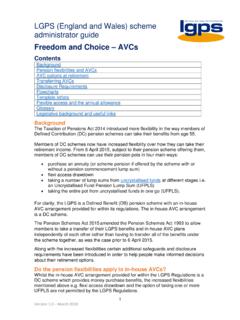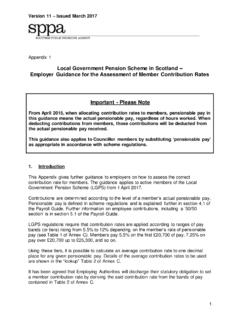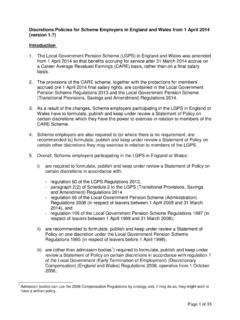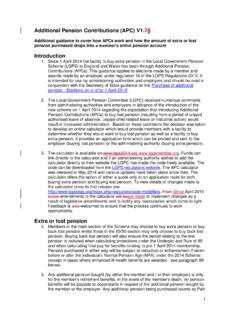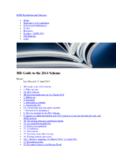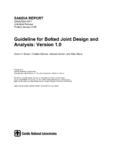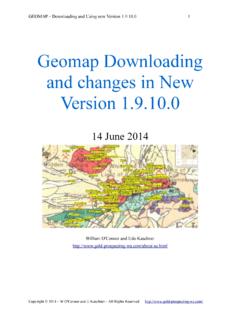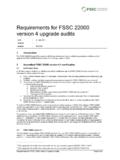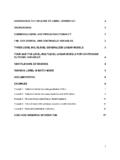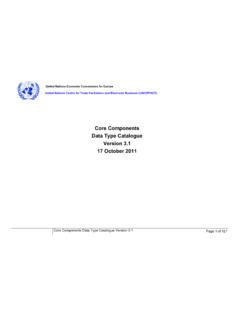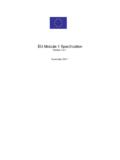Transcription of Aggregation (version 1.8) - lgpslibrary.org
1 1 aggregation ( version ) General principle This paper sets out the rules which, from 1 April 2014, govern the Aggregation of a member s deferred benefit or deferred refund under the LGPS in England or Wales with the member s benefits in an active account in the LGPS in England or Wales. It should be read in conjunction with the paper on the 85 year rule. Where a regulation number is referred to it relates to the relevant regulation in the Local Government Pension Scheme Regulations 2013 unless either a regulation or section from a named set of regulations or Act is quoted or the regulation number is preceded by TP, in which case the regulation number relates to the relevant regulation in the Local Government Pension Scheme (Transitional Provisions, Savings and Amendment) Regulations 2014. Basically: i) A member s deferred benefits - can be aggregated with a member s active pension account. This applies to optants out who rejoin the LGPS in the same way as to a leaver who rejoins the LGPS cannot be aggregated with a deferred member s pension account, a deferred refund account, a retirement pension account, a flexible retirement pension account, a deferred pensioner member s account, a survivor member s account, or a pension credit account.
2 Ii) A member s deferred refund must be aggregated with a member s active pension account cannot be aggregated with a deferred member s pension account, another deferred refund account, a retirement pension account, a flexible retirement pension account, a deferred pensioner member s account, a survivor member s account, or a pension credit account. A summarised version of the Aggregation rules are set out in the sections in Part 1 of this paper. A more detailed version is contained in the sections in Part 2. References in this paper to a public service pension scheme means active membership of a scheme covering civil servants, the judiciary, the armed forces, any scheme in England, Wales or Scotland covering local government workers, or teachers, or health service workers, or fire and rescue workers or members of the police forces; or membership of a new public body pension scheme. [Paragraph 3(2) of Schedule 7 to the Public Service Pensions Act 2013].
3 References in this paper to variable-time employment relate to employment under which an employee s contract provides that their pay is calculated by reference to the duties undertaken (rather than by reference to the number of 2 hours worked). In other words, the employee is paid a fixed sum of money for the work undertaken, regardless of how long it takes the person to undertake the work for example, returning officers and acting returning officers. The references to variable-time employment do not relate to zero hours or variable hours contracts under which employees are paid for the hours of work undertaken. Optants out It should be noted that where a member opts out of the LGPS in their new employment within 3 months of re-joining the scheme their benefits cannot be aggregated as they will have received a refund of contributions through their pay and are treated as not having been a member of the LGPS in the new employment.
4 Where a member opted out of the scheme in an employment prior to 11 April 2015 with an entitlement to a deferred benefit and they subsequently re-join the LGPS the provisions in this document currently apply. However, where a member opts out of the scheme in an employment (other than a concurrent employment) on or after 11 April 2015 with an entitlement to a deferred benefit the provisions in this document do not apply. This is because, by virtue of the amendment made by SI 2015/755 to regulation 22(8) of the LGPS Regulations 2013, such members do not have the right to aggregate benefits upon re-joining the scheme. Thus, administering authorities will need to ascertain from the administering authority holding a deferred benefit for a member who ceased membership on or after 11 April 2015 whether or not that deferred benefit arose as a result of the member opting out of membership of the scheme.
5 The anomaly in treatment between pre and post 11 April 2015 optants out who have deferred benefits has been reported to DCLG for consideration. If a member opts out and only has an entitlement to a refund of contributions, or has a deferred benefit as a result of opting out of a concurrent employment and wishes to aggregate with membership in the ongoing employment, the provisions in this document still apply. Part 1 summarised version The golden rule is that a member s deferred benefits can be aggregated with a member s active pension account whereas a member s deferred refund must be aggregated with a member s active pension account. The above rule applies equally to the cessation of a concurrent employment and also to optants-out just as they do for actual leavers. The complications really start to arise when one looks at the possibility of these events occurring where a person has membership which it to be aggregated which is only post-14 rights, or only pre-14 rights, or a mix of pre-14 and post-14 rights.
6 3 We will look at the possibilities in turn, noting that: whenever automatic Aggregation applies, there is no entitlement to a refund of contributions as an alternative, wherever Aggregation occurs, if the CARE amount and/or Final Salary benefits to be aggregated is/are held in a different Fund, an Inter Fund Adjustment must be paid, where permitted, if a member wishes to retain separate benefits, an election has to be made to the new Fund within 12 months (or such longer period as the new / ongoing employer may allow), where the gap between the member s last day of membership to which the deferred benefit or deferred refund relates and the first day of rejoining the Scheme does not exceed 5 years, the amount in the deferred pension account must be recalculated as if the Treasury Revaluation Orders had applied during that period, and not Pension Increase (Review) Orders. As now, on concurrent membership Aggregation , any pre 1 April 2014 membership is subject to the following adjustment (the rates of pay are as defined in the 2008 Scheme): Membership from the ceased employment multiplied by - Whole time rate of pay from employment which has ceased Whole time rate of pay in the ongoing employment Similarly, where pre 1 April 2014 membership is derived from a variable-time employment and the ongoing employment is not, the membership being aggregated is multiplied by - Annual rate of pay in the variable-time employment Annual rate of pay in the ongoing employment Scenario A post-14 only A1: Active member who has a deferred refund from an earlier period of membership or from a concurrent employment that has ceased and which is based on post 31 March 2014 membership only.
7 Concurrent employment: Automatically aggregated with the ongoing active pension account or, if there is more than one, with whichever one the member chooses. 4 Previous employment: Automatically aggregated with the ongoing active pension account. (Note that the gap between employments cannot be more than 5 years as a deferred refund cannot be held for longer). A2: Active member who has a deferred benefit from an earlier period of membership or from a concurrent employment which has ceased and which is based on post 31 March 2014 membership only. Concurrent employment: Automatically aggregated with the ongoing active pension account or, if there is more than one, with whichever one the member chooses unless the member elects to retain separate benefits. Previous employment: Automatically aggregated with the new active pension account unless the member elects to retain separate benefits.
8 Scenario B mix of pre-14 and post-14 (without 5 year break) B1: Active member who has a deferred refund from an earlier period of membership, or from the cessation of a concurrent employment, which is based on pre 1 April 2014 and post 31 March 2014 membership and the member was an active member on both 31 March 2014 and 1 April 2014 and, since becoming entitled to the deferred refund, the member has not had a continuous break in active membership of a public service pension scheme of more than 5 years. Concurrent employment: Automatically aggregated with the ongoing active pension account or, if there is more than one, with whichever one the member chooses, and the pre 1 April 2014 membership from the concurrent employment that has ceased will entitle the member to a final salary benefit (the membership will be attached to the same ongoing active pension account). Previous employment: Automatically aggregated with the new active pension account and the pre 1 April 2014 membership from the deferred refund will entitle the member to a final salary benefit (the membership will be attached to the new active pension account).
9 5 B2: Active member who has a deferred benefit from an earlier period of membership or from the cessation of a concurrent employment which is based on pre 1 April 2014 and post 31 March 2014 membership and the member was an active member on both 31 March 2014 and 1 April 2014 and, since becoming entitled to the deferred benefit, the member has not had a continuous break in active membership of a public service pension scheme of more than 5 years. Concurrent employment: Automatically aggregated with the ongoing active pension account or, if there is more than one, with whichever one the member chooses, and the pre 1 April 2014 membership from the concurrent employment that has ceased will entitle the member to a final salary benefit (the membership will be attached to the same ongoing active pension account) unless the member elects to retain separate benefits. Previous employment: Automatically aggregated with the new active pension account and the pre 1 April 2014 membership from the deferred benefit will entitle the member to a final salary benefit (the membership will be attached to the new active pension account) unless the member elects to retain separate benefits.
10 If not aggregated, the deferred benefit for the pre 1 April 2014 membership would not retain an ongoing final salary link [see s20 and paragraph 1 of Schedule 7 to the Public Service Pensions Act 2013 and the letter from DCLG at Annex 1]. Scenario C mix of pre-14 and post-14 (with 5 year break) C1: Active member who has a deferred refund from an earlier period of membership which is based on pre 1 April 2014 and post 31 March 2014 membership and the member was an active member on both 31 March 2014 and 1 April 2014 and, since becoming entitled to the deferred refund, the member has had a continuous break in active membership of a public service pension scheme of more than 5 years. The member is only entitled to a refund of contributions, which should already have been paid. 6 C2: Active member who has a deferred benefit from an earlier period of membership which is based on pre 1 April 2014 and post 31 March 2014 membership and the member was an active member on both 31 March 2014 and 1 April 2014 and, since becoming entitled to the deferred benefit, the member has had a continuous break in active membership of a public service pension scheme of more than 5 years.

